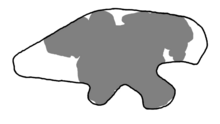| Metriacanthosaurus Temporal range: Oxfordian,
| |
|---|---|

| |
| Ilium of OUM J.12144 (the holotype, with the known remains in grey) | |
| Scientific classification | |
| Domain: | Eukaryota |
| Kingdom: | Animalia |
| Phylum: | Chordata |
| Clade: | Dinosauria |
| Clade: | Saurischia |
| Clade: | Theropoda |
| Family: | †Metriacanthosauridae |
| Subfamily: | †Metriacanthosaurinae |
| Genus: | †Metriacanthosaurus Walker, 1964 |
| Type species | |
| †Megalosaurus parkeri von Huene, 1923
| |
| Species | |
| |
| Synonyms | |
| |
Metriacanthosaurus (meaning "moderately-spined lizard") is a genus of metriacanthosaurid dinosaur from the upper Oxford Clay of England, dating to the Late Jurassic period, about 160 million years ago (lower Oxfordian).
YouTube Encyclopedic
-
1/2Views:1 191614
-
Species Profile: Metriacanthosaurus
-
Dinosaur Battels: Juvenile Allosaurus vs. Metriacanthosaurus (200 Subscriber Special!)
Transcription
History of discovery
In 1923, German paleontologist Friedrich von Huene wrote a paper on Jurassic and Cretaceous European carnivorous dinosaurs within Saurischia. In this paper, he examined a specimen discovered in 1871[1] (OUM J.12144) including an incomplete hip, a leg bone, and part of a backbone, assigning it to a new species of Megalosaurus: Megalosaurus parkeri. The specific name honours W. Parker who in the nineteenth century had collected the fossils near Jordan's Cliff at Weymouth.[2] These bones were from the Oxford Clay Formation, which dates to the Upper Jurassic.[3]
In 1932, however, von Huene concluded it was a species of Altispinax, A. parkeri.[4]
In 1964, scientist Alick Walker decided these fossils were too different from Altispinax, as they lacked the long vertebral spines, and named the new genus Metriacanthosaurus.[5] The generic name is derived from Greek metrikos, "moderate", and akantha, "spine". Metriacanthosaurus thus gets its name from its vertebrae, which are taller than typical carnosaurs, like Allosaurus, but lower than other high-spined dinosaurs like Acrocanthosaurus.
Description

Metriacanthosaurus was a medium-sized theropod with a femur length of 80 cm (31 in). Gregory S. Paul in 1988 estimated its weight at 1 tonne (1.1 short tons).[6] Thomas Holtz gave a length of 8 meters (26.2 feet).[7] Metriacanthosaurus was named for the height of its neural spines, which are actually not overly tall for theropods.[3] They are similar to other theropods such as Megalosaurus, Sinraptor, and Ceratosaurus in being 1.5 times the height of the centrum.[8]
Classification
Originally named as a species of Megalosaurus in Megalosauridae, Metriacanthosaurus has since been reclassified in Metriacanthosauridae. It is thought to be related to genera such as Yangchuanosaurus, and in 1988 Paul synonymized the two genera. However, a 2007 review of British dinosaurs by Darren Naish and David Martill defending keeping the two genera taxonomically separate.[3] Metriacanthosaurus is considered a member of the subfamily Metriacanthosaurinae.[9]
Below is a simplified cladogram of Tetanurae by Matthew Carrano et al. (2012).[9]
| Metriacanthosauridae |
| ||||||||||||||||||||||||||||||||||||||||||
References
- ^ J. Phillips. (1871). Geology of Oxford and the Valley of the Thames. Clarendon Press, Oxford
- ^ von Huene, F. (1923). "Carnivorous Saurischia in Europe since the Triassic". Bulletin of the Geological Society of America. 34 (3): 449–458. Bibcode:1923GSAB...34..449V. doi:10.1130/GSAB-34-449.
- ^ a b c Naish, Darren; Martill, David M. (2007). "Dinosaurs of Great Britain and the role of the Geological Society of London in their discovery: basal Dinosauria and Saurischia". Quarterly Journal of the Geological Society. 164 (3): 493–510. Bibcode:2007JGSoc.164..493N. CiteSeerX 10.1.1.394.9849. doi:10.1144/0016-76492006-032. S2CID 19004679.
- ^ von Huene, F. (1932). "Die fossile Reptil-Ordnung Saurischia, ihre Entwicklung und Geschichte". Monographien zur Geologie und Paläontologie. 1 (4): 361.
- ^ Walker, Alick D. (1964). "Triassic reptiles from the Elgin area: Ornithosuchus and the origin of carnosaurs". Philosophical Transactions of the Royal Society of London. Series B, Biological Sciences. 248 (744): 53–134. Bibcode:1964RSPTB.248...53W. doi:10.1098/rstb.1964.0009.
- ^ Paul, Gregory S. (1988). Predatory Dinosaurs of the World. New York: Simon & Schuster.
- ^ Holtz, Thomas R. Jr (2012). "Dinosaurs: The Most Complete, Up-to-Date Encyclopedia for Dinosaur Lovers of All Ages" (PDF).
- ^ Benson, R. B. J.; Radley, J. D. (2010). "A New Large-Bodied Theropod Dinosaur from the Middle Jurassic of Warwickshire, United Kingdom". Acta Palaeontologica Polonica. 55 (1): 35–42. CiteSeerX 10.1.1.601.354. doi:10.4202/app.2009.0083. S2CID 54680840.
- ^ a b Carrano, M. T.; Benson, R. B. J.; Sampson, S. D. (2012). "The phylogeny of Tetanurae (Dinosauria: Theropoda)". Journal of Systematic Palaeontology. 10 (2): 211–300. doi:10.1080/14772019.2011.630927. S2CID 85354215.















